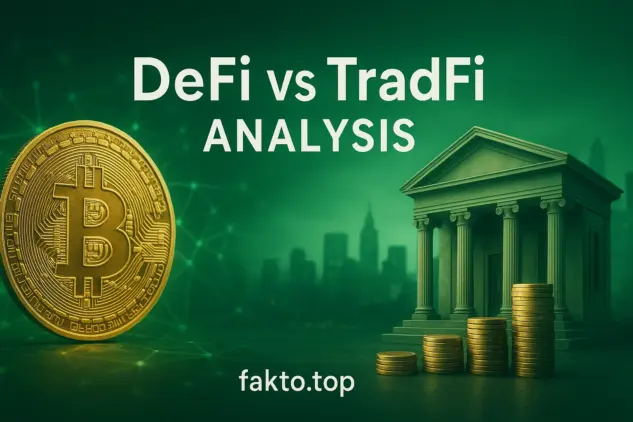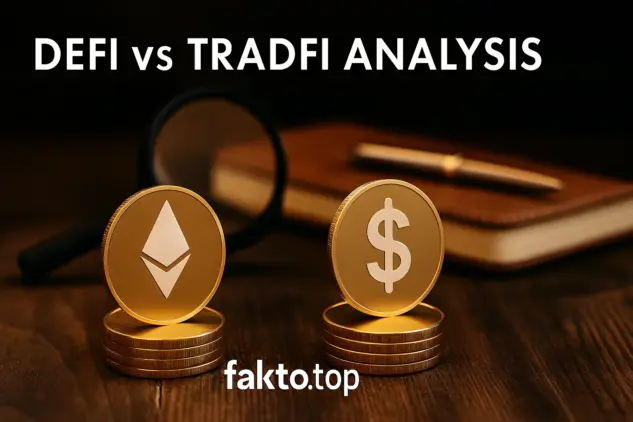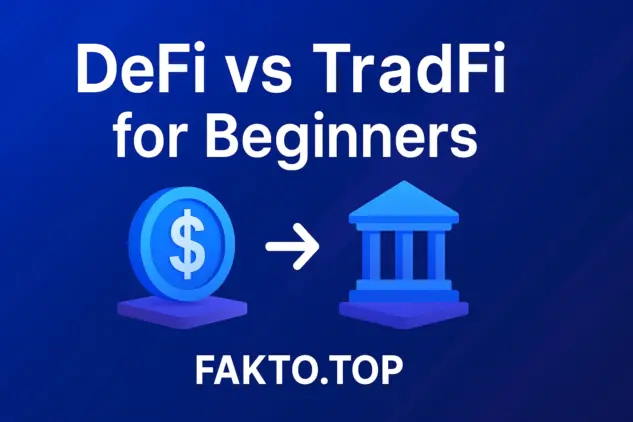DeFi vs TradFi for Beginners: US Crypto Market Analysis & Hybrid Finance Opportunities
DeFi & TradFi clash? Nah, they’re like peanut butter & jelly — different flavors, same awesome combo
DeFi vs TradFi: Analytics & Future of the Two Financial Worlds
DeFi (Decentralized Finance) and TradFi (Traditional Finance) may seem like rivals, but actually they complement each other to turbocharge the financial ecosystem. TradFi is your classic banks, brokerages, and insurance firms, all heavily regulated.
DeFi, on the other hand, is a fresh blockchain playground where smart contracts replace middlemen and yield farming is a lifestyle. Both aim to manage liquidity, lending, investments, insurance, and transparency — just with different approaches.
For crypto enthusiasts in the US, Canada, UK, or Australia, understanding this mashup can uncover juicy investment opportunities. With DeFi at the core, crypto finally lets users control, earn, and move money without middlemen.

Core Similarities & Differences: DeFi vs TradFi
At the heart of both systems is the mission to provide financial services. TradFi leans on trust in centralized institutions — banks, exchanges, insurance companies — giving you consumer protection and risk oversight. DeFi flips the script: smart contracts execute automatically, without humans, offering transparency but also new security and regulatory headaches. The similarity? Both want to optimize capital management, reduce transaction costs, and expand access. The friction? Different philosophies around trust, control, and resilience.
Tech Backbone: Centralized vs Decentralized
Traditional finance = centralized. Banks control the flow, regulators watch over the process. It’s stable but can bottleneck innovation. DeFi = blockchain-powered, distributed ledger. Data verified by multiple nodes, less censorship, more transparency, but scaling and legal accountability are tricky. Think: Bank of America vs Uniswap — one guaranteed by law, one guaranteed by code (watch out for smart contract bugs!).
Regulatory Hurdles & Integration Challenges
DeFi suffers from the lack of clear rules. TradFi is regulated to death — good for consumer safety, boring for innovation. Integrating both? Think hybrid solutions: compliant blockchains, institutional gateways. TradFi can dip into DeFi without breaking laws, and DeFi gets capital & legitimacy. Win-win!

Why DeFi & TradFi Clash
Trust and control — that’s the core of tension. TradFi = human oversight, rules, insurance. DeFi = code, transparency, self-custody. Banks see DeFi as risky, DeFi fans see banks as slow and greedy. Real-world drama includes Fed regulation attempts and debates over digital asset governance.
Market Impact & Economic Interests
DeFi steals some TradFi attention via yield farming & staking, luring deposits away from banks. TradFi fights back with capital, client base, and risk expertise. Both sides competing for capital sparks innovation — crypto meme enthusiasts cheer at APY memes .
Risks & Vulnerabilities
TradFi = credit risk, operational mistakes, systemic crises. DeFi = smart contract bugs, protocol hacks, crypto volatility. Mitigation? TradFi strengthens regulation & internal controls, DeFi audits code & uses insurance and governance mechanisms.
| System | Primary Risks | Mitigation Mechanisms (Security & Safety) |
|---|---|---|
| TradFi |
|
|
| DeFi |
|
|
Examples of DeFi + TradFi Synergy
| Area of Finance | TradFi Pain Point Solved | Hybrid/DeFi Solution | Benefit |
|---|---|---|---|
| Asset Investment | Low liquidity, High entry barriers for private assets. | Asset Tokenization (RWA), Fractional Ownership, Digital Securities. | Increased liquidity, Lower investment minimums, Global access. |
| Global Payments | High fees, Slow settlement (3-5 days), Intermediary risk. | Programmable Money / Stablecoins, Blockchain settlement rails (e.g., institutional DLT). | Near-instant cross-border settlement, Reduced cost and counterparty risk. |
| Lending & Trading | Manual risk assessment, KYC/AML bottlenecks, Trading hours limited. | Smart Contract Automation, Decentralized Identity (DID), 24/7/365 global market access. | Increased speed, Reduced operational cost, Permissionless access. |
Some banks are already using blockchain for faster settlements. Investment funds tokenize assets for crypto investors. DeFi protocols partner with institutions for liquidity & compliance. Hybrid models prove cooperation > conflict.

Asset Tokenization & Digital Securities
TradFi assets tokenized via DeFi = digital securities accessible to retail investors. Benefits? Higher liquidity, lower entry barriers, faster investment flows, regulatory compliance intact.
Smart Contracts in Traditional Services
Banks & insurers integrate smart contracts for automated lending & insurance payouts. Reduces errors, speeds transactions, boosts transparency — everybody wins. Crypto traders might say: “Finally, my chain is strong .”
Future Outlook: Coexistence & Growth
Finance isn’t a boxing match — it’s a remix. DeFi brings speed, transparency, innovation. TradFi brings stability, compliance, experience. Future = hybrid platforms, regulated blockchain systems, new standards. More access, lower risks, stronger trust.
Hybrid Models & Institutional Integration
Decentralized funds + bank participation, or bank-backed DeFi loans = wider markets & more opportunities.
Regulation & New Financial Landscape
Regulators are slowly learning blockchain, balancing innovation vs consumer protection. Transparent rules for DeFi = safer, trustworthy hybrid finance.
Education & Financial Literacy
Users must learn both worlds. Knowledge reduces risks and maximizes profits. Meme tip: “Stay sharp, or your ETH might ghost you .”
DeFi vs TradFi: Side-by-Side Comparison
| Aspect | DeFi | TradFi |
|---|---|---|
| Control | Decentralized, code-based | Centralized, human oversight |
| Transparency | Full via blockchain | Partial, depends on reports |
| Speed | Near-instant settlements | Hours to days |
| Regulation | Emerging, often unclear | Strict & established |
| Access | Global, permissionless | Restricted by geography & KYC |
| Risk | Smart contract bugs, crypto volatility | Credit risk, operational failures |
| Innovation | High, fast-moving | Moderate, slower |
FAQ for Crypto Enthusiasts
What is the main difference between DeFi and TradFi?
DeFi uses blockchain & smart contracts, TradFi uses centralized institutions & human oversight.
Can I use both in the US or UK?
Yes! Many hybrid platforms allow regulated TradFi players to interact with DeFi protocols safely.
Is DeFi safer than TradFi?
Neither is perfectly safe. DeFi risks bugs & hacks, TradFi risks credit & operational failures. Diversify & use audits.
What’s the future of financial markets?
Integration, hybrid models, tokenized assets, institutional adoption + educated crypto users = next-gen finance .
Conclusion & Key Takeaways for Snippets
DeFi + TradFi = combo power for the financial future. Hybrid systems, tokenization, smart contracts, regulation, and financial literacy are crucial. Crypto enthusiasts can profit and innovate by understanding both worlds. 2025 = year of integration & growth for US, UK, Canada, and AU markets.
Disclaimer / No Liability
We are not financial advisors and assume no responsibility for any decisions you make. Cryptocurrencies are highly volatile and risky. You may lose all invested capital.
Always do your own research (DYOR) and consult qualified professionals before making any financial or legal decisions.We make no guarantees regarding the accuracy, completeness, or reliability of the information provided.
References to third-party services or projects do not imply endorsement.By using this site, you agree that all actions are at your own risk and you release the site owners and authors from any liability.
